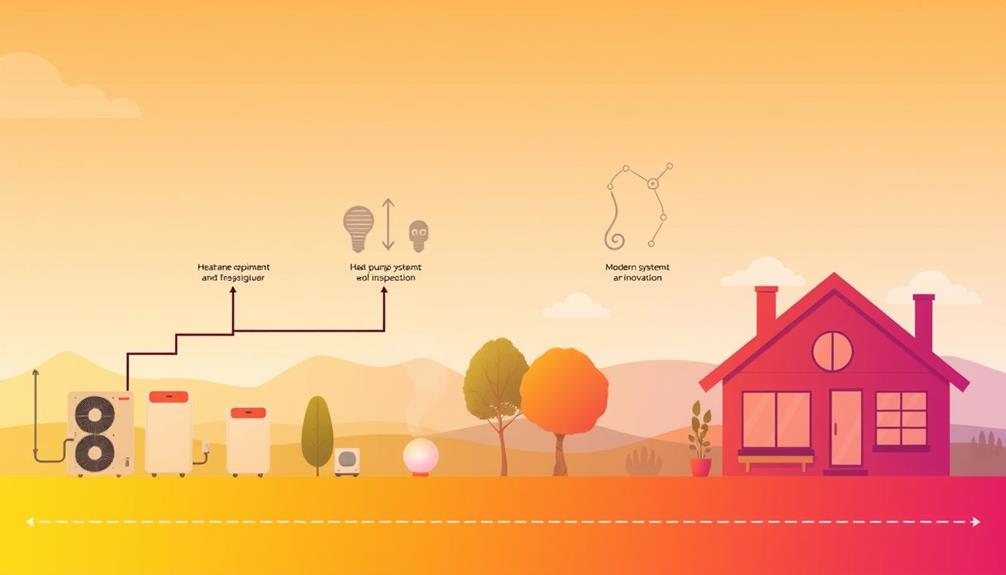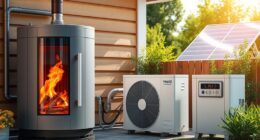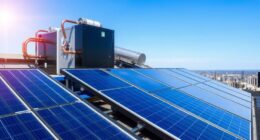When evaluating heat pump efficiency in green buildings, you'll notice a significant difference between air-source heat pumps (ASHPs) and ground-source heat pumps (GSHPs). ASHPs work best in moderate climates, often struggling in colder areas with a COP around 2.357. In contrast, GSHPs maintain a COP of about 2.44 even in chilly environments. They not only provide better energy efficiency, saving operational costs by up to 40%, but also contribute to reduced CO2 emissions. Understanding these differences can enhance your decision-making for energy-efficient solutions. There's much more to explore on this topic, so keep going to uncover additional insights.
Key Takeaways
- Heat pumps, especially GSHPs, can significantly reduce home energy use by 31% to 47%, enhancing green building efficiency.
- Ground Source Heat Pumps (GSHPs) achieve higher COP values than Air Source Heat Pumps (ASHPs), particularly in colder climates, improving overall performance.
- Regular maintenance and optimized design of heat pump systems are crucial for maximizing energy efficiency in green buildings.
- Financial incentives, such as those from the Inflation Reduction Act, facilitate the adoption of efficient heat pump systems in green construction.
- Implementing heat pumps contributes to substantial reductions in greenhouse gas emissions, aligning with sustainability goals in green building initiatives.
Overview of Heat Pump Efficiency
When it comes to energy efficiency, heat pumps stand out as a smart choice for heating and cooling in green buildings.
These systems, whether air-source heat pumps (ASHP) or ground-source heat pumps (GSHP), greatly enhance energy savings. In fact, heat pumps can achieve a coefficient of performance (COP) ranging from 1.8 to 5.0 for heating and from 4.7 to 5.7 for cooling, illustrating their ability to transfer thermal energy effectively.
Regular maintenance is vital to guarantee peak performance and efficiency over time, as common causes of heat pump failures can lead to reduced efficiency.
In colder climates, GSHPs often outperform ASHPs, boasting COP values up to 2.44, which is essential for maximizing efficiency.
The exergy efficiency of ASHPs is about 40.7% in extreme cold, while GSHPs can hit 43.2%, indicating their superior performance under challenging conditions.
Types of Heat Pump Systems
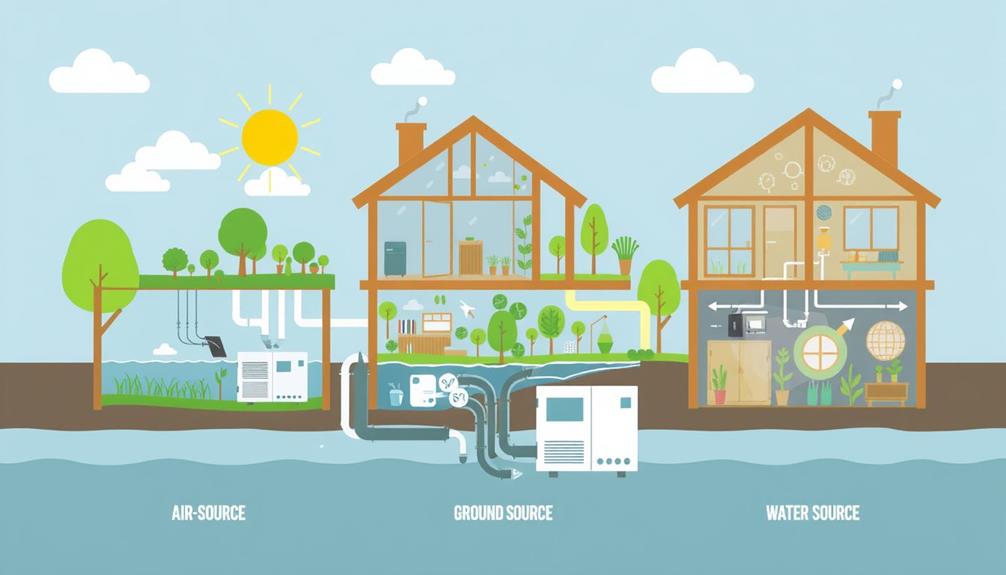
Heat pump systems come in two primary types: air-source heat pumps (ASHP) and ground-source heat pumps (GSHP). ASHPs transfer heat between indoor and outdoor air, making them particularly effective in moderate climates. They achieve a coefficient of performance (COP) ranging from 1.8 to 5.0 in heating mode, providing a reliable heating system.
In regions where renewable energy sources like geothermal energy generation can be harnessed, the performance of heat pumps can be further enhanced. On the other hand, GSHPs utilize stable underground temperatures for heat transfer, demonstrating superior heating efficiency. In colder regions, GSHPs can outperform ASHPs by up to 70%, making them an excellent choice for maximizing thermal comfort.
Both types of heat pumps offer significant energy efficiency and operational cost savings compared to traditional HVAC systems. GSHPs can deliver cost savings of up to 40%, thanks to their higher COP values, often exceeding 4.0.
You might also encounter cascade systems, which use two refrigerants for different temperature cycles, enhancing overall efficiency based on geographic conditions. By selecting the right type of heat pump, you can harness renewable energy effectively while ensuring ideal heating performance in your green building.
Factors Affecting Efficiency
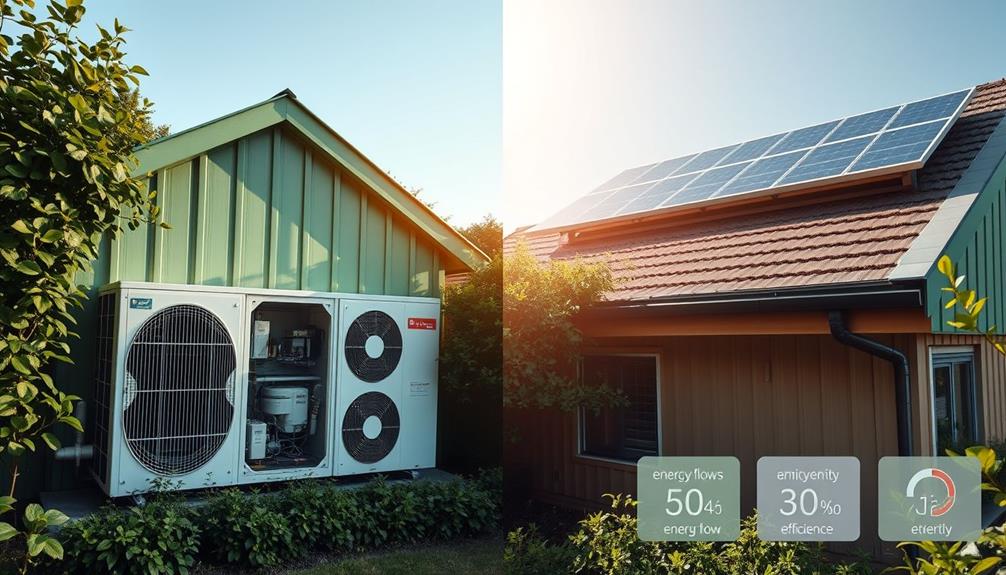
The efficiency of heat pumps can fluctuate based on several factors, impacting their overall performance and energy consumption. One major consideration is the type of heat pump you choose. Air-source heat pumps (ASHPs) can show coefficient of performance (COP) values ranging from 1.8 to 5.0 in heating mode, while ground-source heat pumps (GSHPs) typically achieve COPs between 3.05 and 3.44. This makes GSHPs particularly advantageous in colder climates, where they can deliver up to 70% better heating efficiency due to stable underground temperatures.
Additionally, understanding the importance of effective treatment of depression in maintaining mental health can enhance your overall well-being while maximizing energy consumption in your green building.
Ambient conditions, like condenser inlet and outlet temperatures, also play a vital role in determining efficiency. The design and control strategy of your heat pump system can further enhance energy consumption, as the ideal operating points depend on the specific components and working fluids involved.
Additionally, variations in soil type and moisture levels can greatly affect GSHP performance in different geographic locations. Understanding these factors will help you make informed decisions that maximize the efficiency of your heat pump system, ensuring you get the best performance and energy savings in your green building.
Comparative Analysis of Case Studies
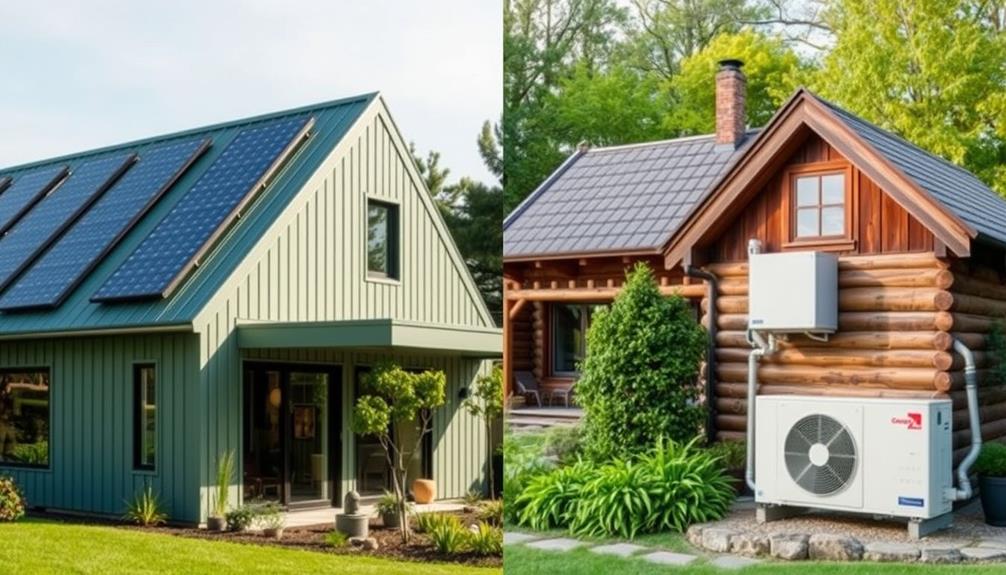
A comparative analysis of case studies reveals considerable insights into the efficiency of heat pumps in green buildings across different climates.
You'll find that air-source heat pumps (ASHP) often struggle in colder regions compared to ground-source heat pumps (GSHP), which maintain stable underground temperatures. For instance, in Saint Petersburg, the ASHP has a coefficient of performance (COP) of 2.357, while the GSHP boasts a COP of 2.44, showcasing its superior heat transfer efficiency.
Additionally, effective weight loss strategies can improve the overall performance of building occupants by encouraging healthier lifestyles, which may indirectly influence building energy use.
Further, GSHPs can provide remarkable energy savings, potentially lowering operational costs by up to 40% compared to traditional systems, which translates to a reduction of approximately 140 tons of CO2 emissions annually.
Numerous case studies highlight how optimized heat pump systems enhance the overall energy efficiency of green buildings, with reductions in home energy use ranging from 31% to 47%, depending on the efficiency ratings of the systems.
Additionally, research comparing local certification frameworks like Turkey's B.E.S.T. with LEED and BREEAM demonstrates that these frameworks can considerably improve energy management strategies in green buildings, optimizing resource consumption while ensuring occupant comfort.
Environmental and Economic Impacts

Optimizing heat pump systems not only enhances energy efficiency in green buildings but also yields significant environmental and economic benefits. By adopting heat pumps, you can reduce your home energy use by 31% to 47%, translating to economic savings on energy bills ranging from $300 to $650 annually. This shift contributes to a nationwide decline in greenhouse gas emissions, potentially reducing emissions in the residential sector by 36% to 64% when replacing fossil fuel heating systems.
| Impact Type | Benefits | Financial Aspects |
|---|---|---|
| Environmental | Reduced greenhouse gas emissions | Long-term savings offset installation costs |
| Economic | Significant energy cost reductions | Financial incentives available |
| System Type | Ground Source Heat Pumps outperforming traditional systems | Lifespan of over 50 years guarantees cost-effectiveness |
Ground Source Heat Pumps (GSHPs) achieve higher efficiency than traditional systems, improving heating efficiency by 70% and cooling efficiency by 20-40%. With financial incentives like those from the Inflation Reduction Act, the barriers of high installation costs diminish, making it easier for households to invest in renewable energy solutions that combat climate change and enhance the building sector.
Frequently Asked Questions
What Is the Comparison Heat Pump Efficiency?
When comparing heat pump efficiency, you'll find air-source heat pumps (ASHPs) generally have lower performance in extreme cold, while ground-source heat pumps (GSHPs) offer higher efficiency and stability, especially in colder climates.
How Efficient Is a Heat Pump Compared to a Geothermal System?
Imagine cozying up in a warm blanket on a chilly day. When comparing heat pumps to geothermal systems, you'll find geothermal systems often shine brighter, especially in cold climates, delivering superior efficiency for your comfort needs.
What Is the Theoretical Efficiency of a Heat Pump?
The theoretical efficiency of a heat pump, measured by its Coefficient of Performance (COP), typically ranges from 1.8 to 5.0 in heating mode, depending on system type and operational conditions. You'll see significant variations.
How Do Heat Pumps Have Over 100% Efficiency?
Heat pumps achieve over 100% efficiency by transferring heat instead of generating it. You're utilizing energy from low-temperature sources, allowing you to move more energy than you consume, resulting in a coefficient of performance above one.
Conclusion
In the domain of green buildings, understanding heat pump efficiency is like finding the secret ingredient in a recipe—it's essential for peak performance. By exploring different systems and their influencing factors, you've seen how efficiency varies and impacts both the environment and your wallet. As you move forward, remember that the choices you make today can shape a sustainable tomorrow, ensuring that your building not only thrives but also contributes positively to the world around you.




